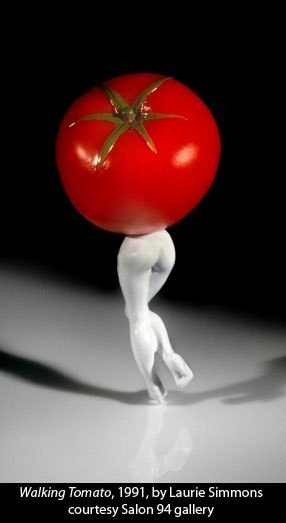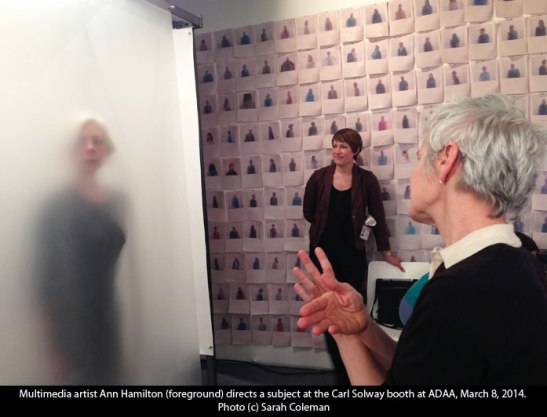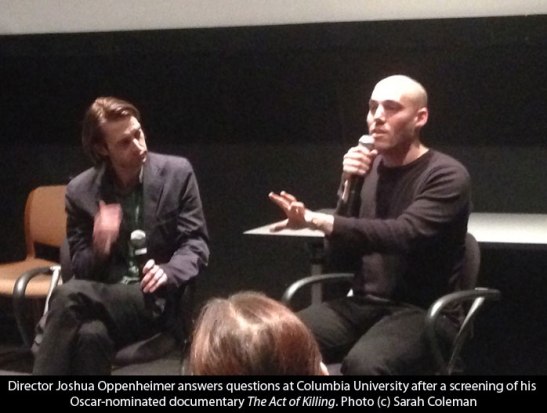From a Walking Tomato to Death Squads: Saturday in New York
 Art is ennobling, art is one of the highest expressions of human civilization …and sometimes, art can be downright weird. I say this in the wake of a six-hour blitzkrieg of artistic activity, otherwise known as Saturday afternoon in New York.
Art is ennobling, art is one of the highest expressions of human civilization …and sometimes, art can be downright weird. I say this in the wake of a six-hour blitzkrieg of artistic activity, otherwise known as Saturday afternoon in New York.
Spring is the season for art fairs in this city, and this past weekend was notable for having both the Armory Show at Piers 92 and 94, and the Art Dealers Association of America show at (confusingly) the Park Avenue Armory. Both fairs purport to show what’s new and hot, though the Armory Show is bigger, more cutting-edge, and something of a zoo, whereas ADAA feels manageable and refined.
Since having young children isn’t generally conducive to peacefully browsing art, I normally wouldn’t have made it to either fair. But a class I’ve been taking recently, Photo Collecting, was meeting at ADAA. I was happy to go since I find art fairs enjoyable: the dealers are usually friendly and the booths are set up for quick, intense encounters, like speed-dating for images.
At ADAA 2014, the photography galleries (which were naturally our focus) fell into two camps. I’ll call one “old wine in new bottles” and the other “hot from the oven.”
In the “old wine” category was Diane Arbus: Couples, in the Fraenkel Gallery booth. Arbus is old wine indeed, but this show was fresh, featuring a collection of images of couples culled from throughout Arbus’s career. It was an inspired grouping that showed that, throughout her active 15 years, Arbus was not only interested in depicting alienated outsiders but also in capturing a more tender side of human nature. The definition of ‘couples’ was pleasingly broad, encompassing female friends and drag queens as well as more conventional pairings.
At the other end of the spectrum, “hot from the oven,” was the Carl Solway gallery booth. It doesn’t get hotter than this: the art was being made right on the spot. In this interactive piece, passersby could sign up to be photographed behind a sheet of heavy fogged plastic, while multimedia artist Ann Hamilton directed them to connect with the plastic in various ways.
Out of these simple raw materials—a white backdrop, a sheet of plastic and random people—Hamilton managed to create something magical. The images were beautiful and mysterious, and everyone—from participants to onlookers—was enjoying themselves mightily. Just over a year ago, Hamilton transformed this same hall into her joyously interactive exhibition The Event of a Thread. I love how unpretentious and celebratory her work is. These are rare commodities in the art world.
Finally, somewhere between “old wine” and “oven hot” was the exhibit at the Salon 94 gallery booth—a solo show by Laurie Simmons, who’s almost as famous for her eerie photographs of dolls as she is for being Lena Dunham‘s mother. The current show featured some enormous photographs of toy objects—a toilet, a glove, a tomato—stuck onto porcelain figurine legs. And here’s where things became a bit weird. Our photo collecting teacher, the redoubtable Alice Sachs Zimet, is a stickler for knowing the exact date of a photographic print. But as she tried to get information on the Laurie Simmons prints from the pretty young gallery assistant, the conversation went something like this:
 Assistant: They’re from 1991. But they were just reprinted, for archival reasons.
Assistant: They’re from 1991. But they were just reprinted, for archival reasons.
Alice: So these prints on the wall are new?
Assistant: No, not new. They’re from 1991.
Alice: But you said they were just reprinted.
Assistant: Yes. For archival reasons.
Alice: Then they’re new?
Assistant: [Defensive] Well, they were made in 1991, but never printed then. They’ve been printed now. [Voice rising] Nobody has seen the walking tomato before.
I’m sorry, but has there ever been a line more ripe for satire than, “Nobody has seen the walking tomato before”? I suddenly felt as if I was in an episode of Girls—the show where, in season two, Lena Dunham did a masterful takedown of the pretentious fictitious artist Booth Jonathan. The fact that Dunham is Simmons’ real-life daughter made it even more of a funhouse-mirror Art Moment, reflecting the weirdness of a world where an eight-foot walking tomato is treated with the gravitas of a holy relic.
 Anyway, much as I would have loved to hang around appreciating the ambulatory fruit, I had to dash off. I was due at a screening of The Act of Killing at Columbia University: a hot ticket not only because it was an extended cut of the Oscar-nominated documentary, but because director Joshua Oppenheimer was going to do a Q&A afterward.
Anyway, much as I would have loved to hang around appreciating the ambulatory fruit, I had to dash off. I was due at a screening of The Act of Killing at Columbia University: a hot ticket not only because it was an extended cut of the Oscar-nominated documentary, but because director Joshua Oppenheimer was going to do a Q&A afterward.
I think it’s a compliment to say that this was one of the most bizarre films I’ve ever seen, and one of the most morally uncomfortable. It centers on several former Indonesian death squad leaders, men now celebrated for ridding their country of a supposed communist scourge in the 1960s. Proud of their past and shielded by a complicit government, these men offer to reenact their crimes in their favorite movie genres, which range from film noir to musicals. Their lack of remorse in the face of their killing is breathtaking—but, the film encourages us to ask, does it go deep? Can you kill thousands and feel no guilt?
To get to the bottom of this, Oppenheimer and his subjects reach levels of surrealism that leave Laurie Simmons’ walking tomato in the dust. To begin with, these mass murderers come across less as monsters than as mild grandfatherly types, who just happen to be boasting about strangling hundreds of men with wire. And the film is bookended by musical numbers where colorful dancers undulate next to a four-storey, dilapidated concrete goldfish that sits at the edge of a beautiful lake. The fish is never explained: it’s just there, a weird, dreamlike symbol that could have come out of a Magritte painting.
Other bizarre details—like a museum of death—are introduced without explanation, too, and in this way Oppenheimer subverts the traditional, educative documentary genre and instead makes the viewer feel queasily unmoored. For those of us who know Indonesia mostly as a country where President Obama spent some formative years, this is shocking but effective. It’s like entering into a nightmare, or—as Oppenheimer said after the screening—“wandering into Germany forty years after the Holocaust, only to find the Nazis still in power.” Rightly or wrongly, the movie gives the impression that Indonesia is one f—ed up place.
In the Q&A, Oppenheimer connected some dots. He hadn’t expected the reenactment scenes “to reach such surreal heights,” he said, but felt it underpinned the message that “great violence like this… is the underbelly of our reality.” He made the audience squirm in its seats with assertions that we’re all implicated in Indonesia’s corruption—from the American government that “enthusiastically supports the regime of the killers” to those of us who buy toiletries containing Indonesian palm oil in CVS. As for the concrete fish? It was a former seafood restaurant, known for its carp. The filmmakers drove past it one day, and were fascinated: they felt its tarnished beauty perfectly fit their subject matter.
So there we have it: the walking tomato and The Act of Killing, two uses of surrealism that couldn’t be more different. Going from one to the other in a single afternoon was in itself pretty weird, a reminder of how complicated and multifarious both people and art can be. Nobody has seen the walking tomato before, and believe me, you won’t have seen a movie quite like The Act of Killing. Of course, novelty has value: it wakes us up. But when we get past the shock of the new, what’s left?
Naturally, it would be unfair to compare Simmons’ offbeat, gently satirical work to a film of such enormous moral dimension. But going from one to the other, I was left with the feeling that size matters. At almost three hours long, Oppenheimer’s film felt necessary. But at eight feet tall, Simmons’ walking tomato felt a bit too big for its porcelain boots.
—————————————————————
A note to subscribers: If you have subscribed to receive The Literate Lens by email, it’s possible that new articles are being sent to your Spam folder. I’ve researched this problem, and it seems there’s nothing to be done on the WordPress end, which is very frustrating. If you want to make sure your email from the site doesn’t go to Spam, directions from WordPress are posted below. For Gmail users, directions for fixing this problem are posted here.
- Check your spam/junk email box. If you have an option to unblock specific email addresses, try allowing
*@wordpress.com(all emails from the domain) and/orno-reply@wordpress.comaddresses. - Make sure you to uncheck the box next to “Block all email updates from WordPress.com blogs you follow” on your Email Delivery Settings page.
4 comments on “From a Walking Tomato to Death Squads: Saturday in New York”
Leave a Reply
Connecting to %s






A fascinating article, Sarah! I have read a bit about that movie before and have been a bit hesitant to watch it but somehow it intrigues me, as does that huge carp.
Thank you, Karen! It’s definitely a difficult film to watch, but an important one. And the original way it approaches its subject matter is extremely thought-provoking.
Hilarious references about Lena Dunham and her mother, along with the Indonesian “reenactment ” death squads, and all the serious art hoopla, old wine, new wine, the old/new Arbus retreads, made Walking Tomato Death Squads an enjoyable read. Thanks Sarah.
You’re welcome, Hilton! Thanks for stopping by.